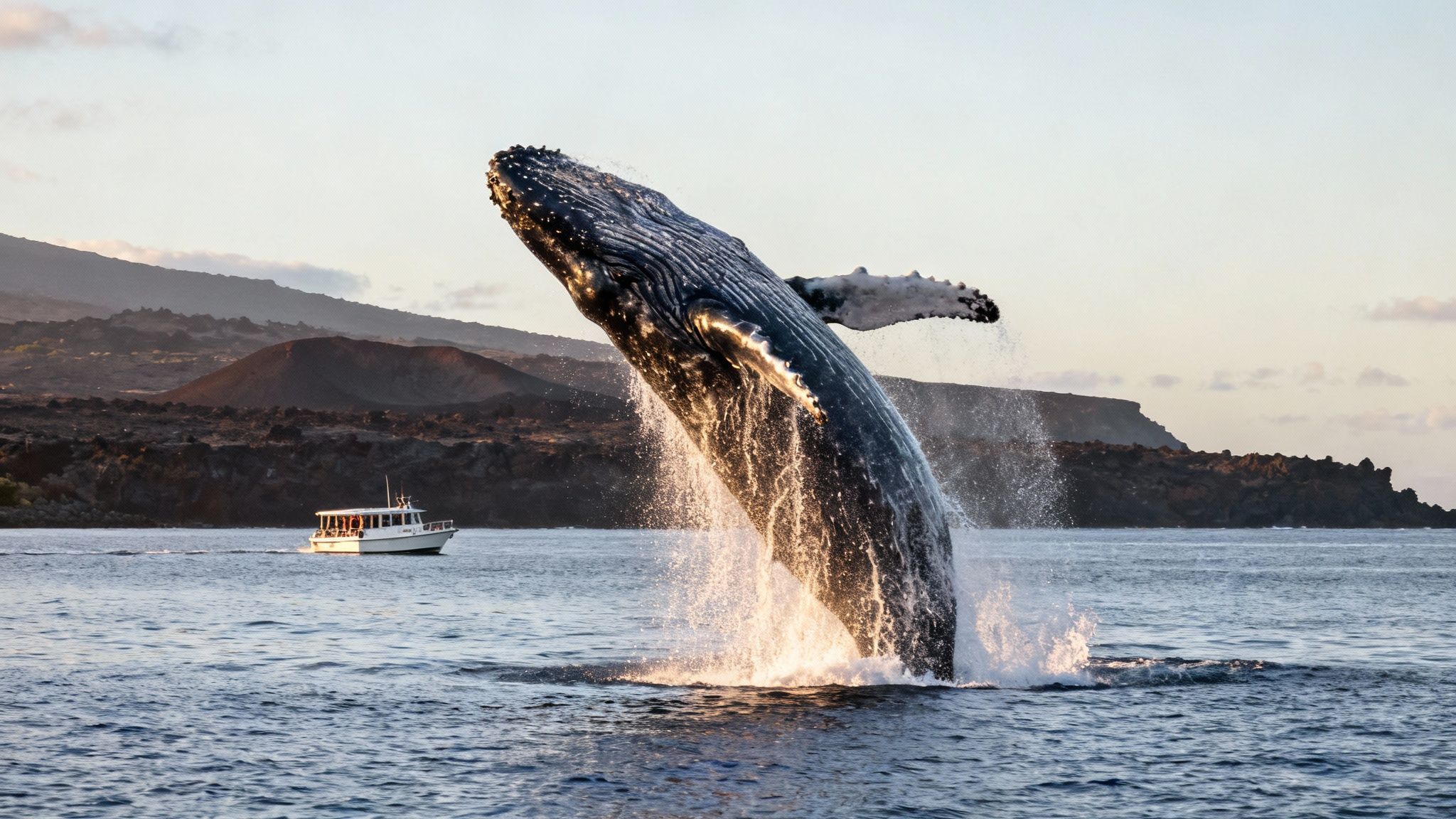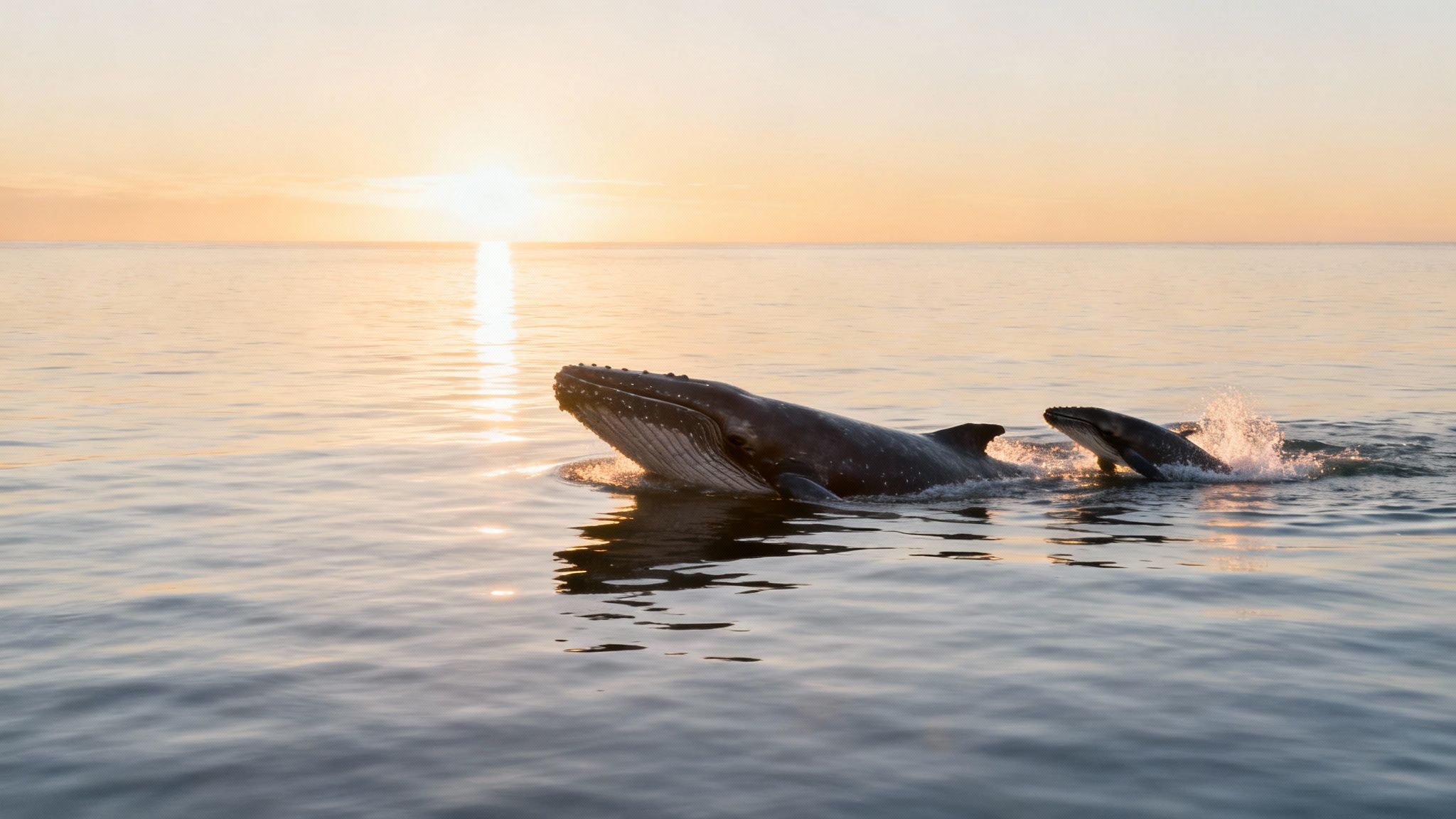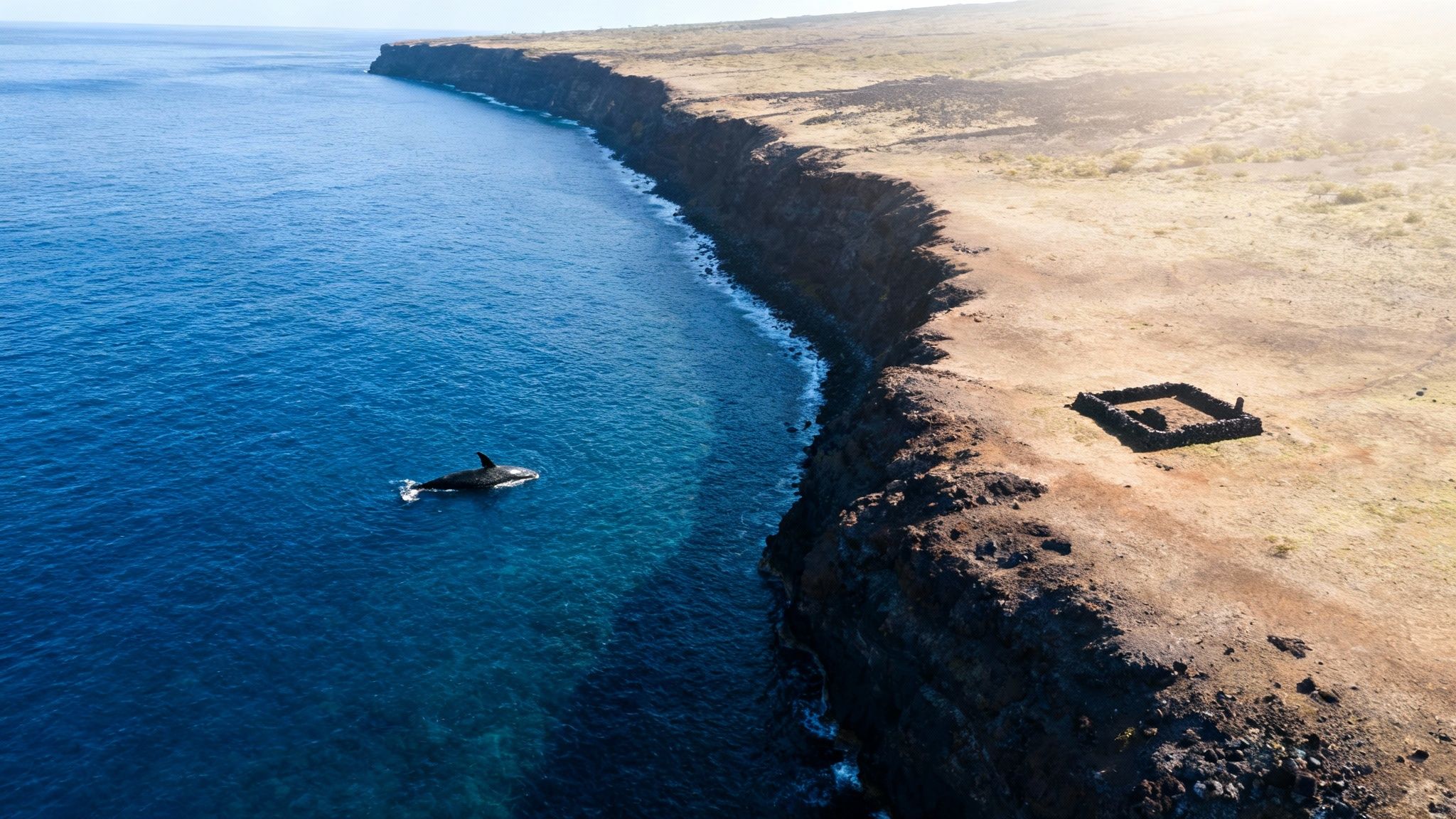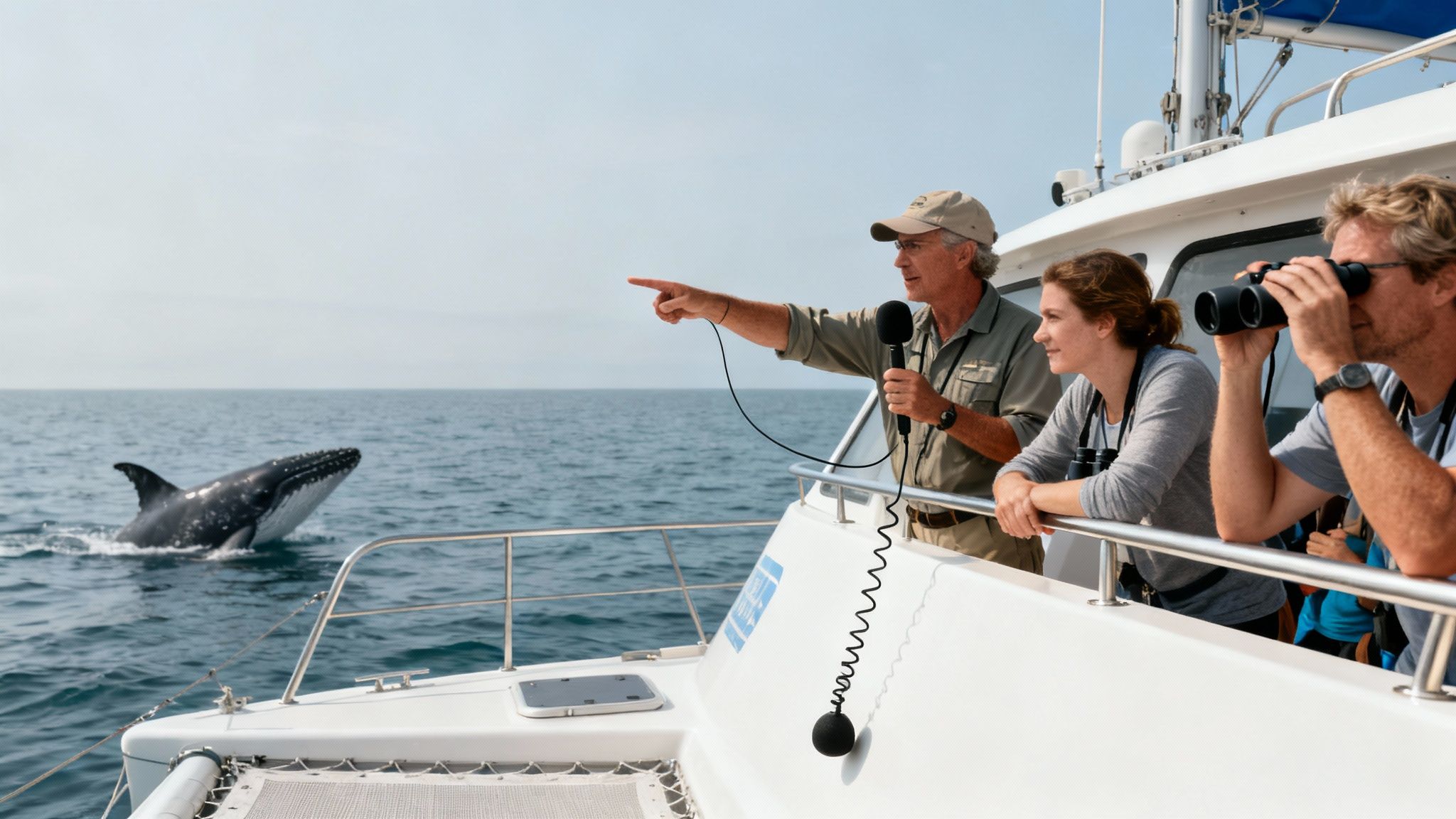Your Guide to whale watching big island: Top Tips

Can you imagine it? The ocean's surface suddenly explodes as a 40-ton humpback whale throws itself completely out of the water. For jaw-dropping whale watching, the Big Island is hands-down one of the best places on the planet, giving you a front-row seat to one of nature's greatest shows. This guide is your ticket to making that unbelievable moment a reality.
To make an adventure like this truly seamless, you'll want to go with an experienced crew who knows these waters and these whales. Kona Snorkel Trips is the top rated & most reviewed snorkel company in Hawaii, and for good reason—we live for this stuff. See for yourself what fellow travelers have to say about their incredible days out on the water with us.
Witnessing Giants on the Big Island
Every winter, something magical happens. The calm, sheltered waters off the Kona and Kohala coasts become a massive nursery for thousands of humpback whales. This isn't just a quick stop; it's the final destination of an epic migration. These gentle giants travel thousands of miles from their feeding grounds in Alaska to these specific Hawaiian waters to breed, give birth, and raise their newborn calves.

A Remarkable Comeback Story
Seeing these whales is even more special when you know their history. The population of humpbacks that journeys here has made a stunning comeback. Back in the 1960s, they were hunted nearly to extinction. Today, the Pacific humpback whale population is estimated to be around 26,000 strong, with a huge portion of them spending their winters right here in Hawaiian waters. It's a truly amazing conservation success story, and you can read more about it on the Big Island.
Understanding Whale Behaviors
Part of the thrill of whale watching on the Big Island is getting to see their famous behaviors up close. Every splash and slap has a purpose, whether it's for communication, a warning, or just pure, unadulterated play.
- Breach: This is the big one! It's that iconic, explosive leap where a whale launches almost its entire body out of the water before crashing back down.
- Tail Slap: You'll see (and hear) a powerful smack of the tail, or fluke, on the water's surface. This can be a way of talking to other whales or showing a bit of agitation.
- Pectoral Fin Slap: Whales will often roll onto their sides and repeatedly slap their long pectoral fins on the water. It makes a surprisingly loud sound!
- Spyhop: This is just pure curiosity. A whale will poke its head straight up out of the water, almost like it's treading water, just to get a good look around at what's happening on the surface.
There's nothing quite like feeling the presence of these massive, intelligent animals. It’s a humbling experience that connects you directly to the raw, untamed power of the ocean.
When to Go for the Best Whale Sightings
Timing your trip for the best whale watching on the Big Island can make the difference between a good day and an unforgettable one. It's the key to everything.
While the first humpback whales start showing up in Hawaiian waters as early as November, the real action doesn't get going until winter truly sets in. The official season runs from late November through April, which gives you a pretty generous window to plan your adventure.

Seeing those early arrivals in November and December is always a thrill—it means the season has officially begun! But if you want to be in the thick of it, you’ll want to wait until the whale population hits its peak.
That's when the waters off Kona are just electric with activity. We're talking mothers nursing newborn calves, and powerful males putting on breathtaking shows as they compete for mates. It’s a sight to behold.
The Peak of the Peak Season
For the absolute best chance of frequent, jaw-dropping sightings, you can't beat January and February. This is when the number of whales in the waters off the Big Island maxes out. It’s not just a feeling; local whale counts back it up year after year.
This is the sweet spot. A time when seeing multiple pods on a single tour is not just possible, but pretty common. We dive deeper into what makes this period so incredible in our complete guide to the Big Island whale season.
To help you visualize the season's progression, here’s a quick breakdown of what you can generally expect month by month.
Big Island Whale Watching Season at a Glance
This table gives you a snapshot of whale activity levels throughout the official season, so you can plan your trip for the experience you're hoping for.
| Month | Whale Activity Level | Typical Sightings |
|---|---|---|
| November | Low | The first arrivals start to appear, sightings are sporadic but exciting. |
| December | Moderate | Numbers are building. More consistent sightings, often in smaller groups. |
| January | Peak | The highest concentration of whales. Frequent, dynamic activity is common. |
| February | Peak | Activity remains at its highest. Excellent for seeing competitive pods and calves. |
| March | High | Still fantastic viewing as whales begin their slow departure. |
| April | Moderate to Low | The last of the whales head back to Alaska. Sightings become less frequent. |
As you can see, while the season is long, hitting that January-February window gives you the best odds for a truly spectacular day on the water.
Morning vs. Afternoon Tours
Once you've picked your month, the next decision is what time of day to head out. Honestly, there's no bad choice here—both morning and afternoon trips have their own unique vibe.
- Morning Tours (Typically 8 AM – 12 PM): The ocean is often at its calmest first thing in the morning. We call it "glass," and those glassy conditions make it super easy to spot whale spouts from a distance. The soft light is also a photographer's dream, cutting down on the harsh midday glare.
- Afternoon Tours (Typically 1 PM – 5 PM): The wind can pick up a bit in the afternoon, creating more of a surface chop, but the whales don't seem to mind one bit. The afternoon sun can create some really dramatic, backlit photos of breaches and tail slaps, casting a gorgeous golden glow on the water as the day winds down.
Ultimately, you really can’t go wrong during peak season. A lot of people prefer the morning for the calm seas, but an afternoon trip offers an equally beautiful, and sometimes more dramatic, perspective. No matter when you go, seeing humpbacks in their natural winter home is an experience that will stick with you forever.
Finding the Best Whale Watching Hotspots
When it comes to whale watching on the Big Island, location is everything. The island's sheer size creates wildly different conditions from one coast to the next, and let me tell you, the whales definitely play favorites. They make a beeline for the calm, protected waters on the leeward side of the island, specifically along the Kona and Kohala Coasts.
Think of this whole area as one massive, serene nursery. The towering volcanoes of Mauna Kea and Mauna Loa act as a giant shield, blocking the powerful trade winds that batter the other side of the island. The result is an ocean that’s significantly calmer—exactly what a migrating humpback mother is searching for. She needs a safe harbor to give birth and nurse her newborn calf, far away from turbulent, open seas.

Why the Kona Coast Is a Whale Sanctuary
The advantages of the Kona and Kohala Coasts go much deeper than just the surface conditions. It turns out the underwater geography here is perfectly suited for humpbacks, too.
Unlike many places where the ocean floor slopes gently away from the shore, the seabed off the Big Island's west coast is dramatic. It drops off a cliff, creating incredibly deep water just a stone's throw from the coast. This unique feature means mothers and their calves can rest and bond in the safety of the deep without straying far from land.
It's this combination that makes the area so special. It gives the whales the security they need while keeping them easily accessible for us to watch respectfully. When you start a tour from Kona, you’re launching directly into the heart of this prime habitat. Less travel time means more whale time.
The mix of calm seas and deep nearshore waters makes the Kona Coast one of the most reliable and spectacular whale watching destinations on the planet. It’s a natural sanctuary that draws thousands of humpbacks back, year after year.
Shoreline Viewing Opportunities
While getting out on a boat is the most immersive way to see the whales, you can absolutely spot them from shore. If you know where to look, certain spots offer elevated vantage points that are perfect for scanning the horizon. You're looking for that telltale spout of a breathing whale or the unmistakable splash of a breach.
One of the most legendary spots is the Puʻukoholā Heiau National Historic Site. The name itself even translates to "hill of the whale," which tells you everything you need to know about its long history as a prime viewing area.
A few other great locations to try are:
- Kapaʻa Beach Park: A beautiful spot where whales are often seen cruising by.
- Lapakahi State Historical Park: This park offers wide-open, unobstructed views of the ocean.
- Resorts along the Kohala Coast: Many have stunning oceanfront lawns and viewpoints perfect for a little impromptu whale watching.
Shoreline viewing is a fantastic way to spend an afternoon, but nothing quite compares to being on the water. A tour departing from Kona not only gets you closer to the action but also gives you the benefit of a seasoned crew who knows these waters and knows exactly where to look.
How to Choose the Right Whale Watching Tour
Picking the right tour for whale watching on the Big Island is easily the most important call you'll make for your trip. It's the difference between a simple boat ride and a truly profound experience with some of the planet's most incredible animals. With a bunch of operators to choose from, knowing a few key things will help you land on a top-notch, responsible company like Kona Snorkel Trips.
Your adventure starts with the boat itself. The kind of vessel you're on really sets the whole vibe for the day, from how close you feel to the action to how comfortable you are.
Vessel Types: The Pros and Cons
Different boats make for wildly different days on the water. A zippy little zodiac offers a thrill ride, while a big, stable catamaran is all about kicking back in comfort.
- Zodiacs (Rigid-Hulled Inflatables): Think fast, agile, and low to the water. These boats give you a thrilling, spray-in-your-face perspective that's hard to beat. The trade-off? It’s a bumpier ride with minimal creature comforts—don't expect a restroom or much shade.
- Catamarans: With their dual hulls, these larger boats are incredibly stable, making them a perfect pick for families or anyone who gets a little wobbly on the water. They’ve got tons of deck space, shaded areas, and onboard restrooms, prioritizing a relaxing, comfortable day at sea.
It’s worth noting that whale watching is a huge part of our local economy here. Back in 2008, an estimated 330,000 people went on tours during the short 120-day season, supporting a thriving local industry. You can even see the industry's local impact on the NOAA website.
The Importance of a Naturalist Guide
A truly great tour isn’t just about seeing whales; it’s about understanding them. This is where a seasoned naturalist guide is worth their weight in gold. They do more than just point to a spout on the horizon—they translate the incredible behaviors you're witnessing right in front of you. A good guide can tell you if you're watching a competitive pod of males or a mother patiently teaching her calf, turning a good trip into an unforgettable educational adventure.
An expert guide is the storyteller of the sea. They bring the world of the humpback whale to life, sharing insights about their migration, communication, and social structures that you’d never get from a guidebook.
Responsible Tourism and What to Look For
Choosing a tour operator who respects the whales is absolutely essential. Responsible tourism ensures these magnificent creatures are protected so future generations can experience the same awe that we do. Federal law is crystal clear: all boats must stay at least 100 yards away from humpback whales. A reputable company will follow this rule to the letter, always putting the whales' well-being first.
For a deep dive into what makes a tour stand out, check out our guide on the best whale watching tours in Kona Hawaii.
When you're ready to book, keep an eye out for these game-changing features:
- Hydrophones: These are basically underwater microphones that let you listen in on the complex, hauntingly beautiful songs of the male humpback whales in real-time. It's an experience that will give you goosebumps.
- Sighting Guarantees: Operators who are confident in their ability to find whales will often offer a sighting guarantee. It’s pretty simple: if you don't see whales on your trip, you get to come back again for free.
What to Expect on Your Whale Watching Adventure
So, you've booked your tour and are counting down the minutes to an incredible day of whale watching on the Big Island. Let's talk about what the adventure actually looks and feels like, from the second you step on board to that heart-stopping first whale sighting.
Your day kicks off with a warm "aloha" from our crew as you get settled. After a quick safety chat, we'll cruise out of the harbor and into the deep blue waters the humpbacks call their winter home. Your guide will be glued to the horizon, scanning for those telltale signs—a distant puff of mist from a blowhole or the massive splash of a breach that can be seen for miles.

Decoding Whale Behaviors in Real Time
When you finally spot them, it’s pure magic. Seeing a humpback whale in person is the only way to truly appreciate its sheer scale. Try to imagine something the size of a school bus effortlessly launching its 40-ton body completely out of the water. That's a breach, and it’s a display of raw power that will leave you absolutely speechless.
But there are other, more subtle behaviors that are just as fascinating to witness.
- Spyhop: A whale might just poke its head straight out of the water to get a good look at the boat. It’s a moment of mutual curiosity that feels incredibly personal.
- Pec Slap: The whale rolls onto its side and slaps its long pectoral fin on the surface, creating a surprisingly loud thwack that echoes across the ocean.
- Tail Slap: This is a powerful smack of the fluke (tail) on the water. It's often used for communication or just to show who's boss.
One of the most unforgettable moments is when the crew lowers a hydrophone into the water. Hearing the complex, haunting songs of male humpbacks live is like listening to a concert from another world—a deeply moving experience that connects you directly to the life hidden just beneath the waves.
Your Essential Packing Checklist
A little preparation goes a long way toward making your day on the water as comfortable and enjoyable as possible. The weather can change in a flash out here, so it’s best to be ready for anything.
- Layered Clothing: A light jacket or windbreaker is always a good idea. Even on a sunny Hawaiian day, it can get cool and breezy once we're moving.
- Sun Protection: The sun is no joke out here. Bring reef-safe sunscreen, a wide-brimmed hat, and polarized sunglasses to cut the glare off the water (it helps with spotting whales, too!).
- Camera or Smartphone: You’ll definitely want to capture these memories, so make sure your device is fully charged. A waterproof bag isn't a bad idea either, just in case of sea spray.
- Seasickness Medication: If you're prone to motion sickness, take your preferred remedy before you board the boat. Ginger chews or acupressure bands are also popular natural options that work for many people.
- Binoculars: While not essential, a good pair of binoculars can give you an incredible up-close look at the whales from the regulated 100-yard distance.
With the right gear and an adventurous spirit, you’re all set for a day you’ll be talking about for the rest of your life.
Discovering Other Marine Life On Your Tour
Sure, the humpback whales are the headliners, but don't forget about the incredible opening acts! Your whale watching tour is really a full-blown marine safari. The waters off the Kona coast are teeming with life, and you never know who's going to show up to the party.
Keep an eye out for pods of spinner dolphins, famous for their unbelievable acrobatic leaps and spins. They love to race alongside the boat, playing in the wake. You might also spot their larger, more thoughtful cousins, the bottlenose dolphins, who often seem just as curious about us as we are about them.
The Supporting Cast of the Kona Coast
Beyond the dolphins, the list of potential co-stars on your tour is long and always a surprise. That's what makes every trip out on the water completely unique.
You may spot:
- Pilot Whales: These smaller toothed whales are super social creatures, almost always traveling in tight-knit family groups.
- Hawaiian Green Sea Turtles (Honu): Seeing a majestic honu glide effortlessly to the surface for a breath is always a magical moment.
- Manta Rays: On a lucky day, you might witness the breathtaking sight of a giant manta ray cruising near the surface, its massive wings propelling it through the deep blue.
These encounters are what make Hawaiian waters so vibrant and special. In fact, many people who see a manta for the first time are instantly hooked and want a closer look. If that's you, you can learn all about these gentle giants in our guide to snorkeling with manta rays in Hawaii.
And when you’re back on dry land, the Big Island is packed with other family-friendly outdoor adventures and kid-friendly hikes to keep the excitement going.
Your Whale Watching Questions Answered
As you get ready for an amazing whale watching Big Island adventure, a few final questions always seem to pop up. We’ve been there. So, we've gathered the most common ones to give you the clear, straightforward answers you need to book your tour with total confidence.
Is a Whale Sighting Guaranteed on a Tour?
While whales are wild animals and nobody can ever make a 100% promise, your chances of seeing them during peak season (January-February) are incredibly high. The best tour operators have such a stellar success rate that they often offer a "sighting guarantee."
Usually, this means you can hop on another tour for free if you don't spot any whales. It’s always a good idea to double-check the specific policy with the company you book with.
How Close Can Tour Boats Get to the Whales?
To keep these magnificent animals safe, strict federal laws are in place. All boats must stay at least 100 yards away from humpback whales.
But here’s the magic of it all: whales are curious. It’s pretty common for them to decide to approach a stationary boat on their own. This can lead to a breathtaking, up-close encounter that happens completely on their terms. A responsible captain will always put the whales' well-being first by respecting these rules.
For your own peace of mind on the trip, getting a handle on travel insurance is a smart move. Understanding What does travel insurance cover? can be a real lifesaver if any unexpected situations pop up.
What Is the Best Camera for Whale Watching?
If you want those frame-worthy shots, a camera with a good zoom or a telephoto lens is your best friend. From 100 yards away, that extra reach makes all the difference. A fast shutter speed is also key to freezing the action when a whale breaches—it happens in a flash!
Modern smartphones can also get some incredible pictures, but don't forget a waterproof bag. A little sea spray is part of the fun, but your phone won't think so!
Are Children Welcome on Whale Watching Tours?
Absolutely! Whale watching is an unforgettable experience for the whole family. Most tour companies love having kids on board.
It's always smart to check for age restrictions, particularly on smaller, zippier boats like zodiacs. For families with young children, a larger, more stable catamaran is often the most comfortable choice, usually offering amenities like restrooms and shady spots to relax.
Ready to see the magic of the humpback whales for yourself? Join Kona Snorkel Trips for an adventure on the water you won't soon forget. Book your tour today and make some memories that will last a lifetime.
